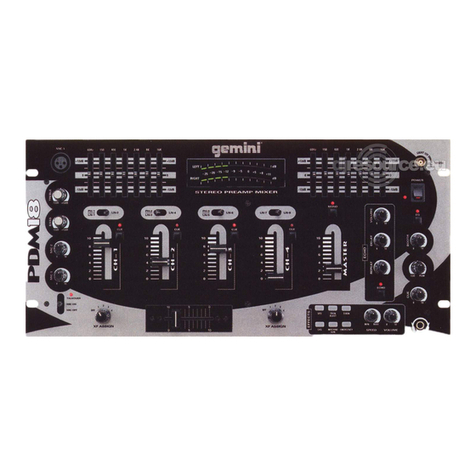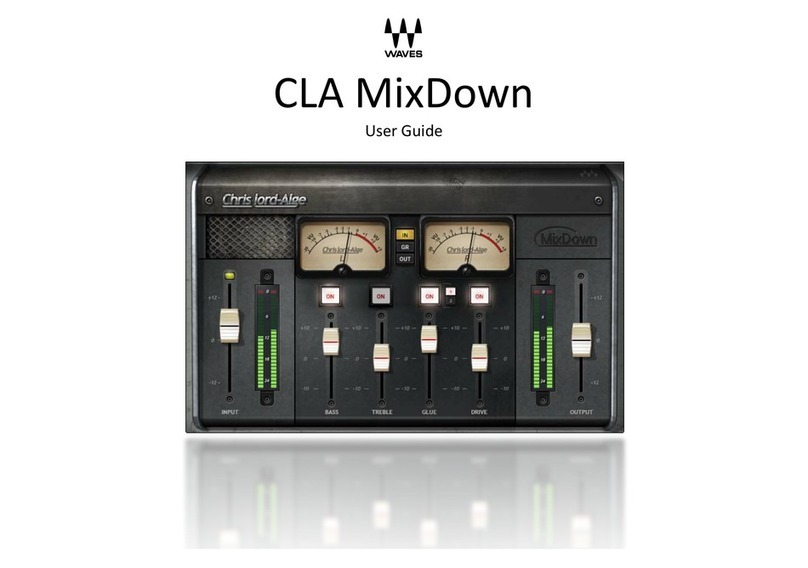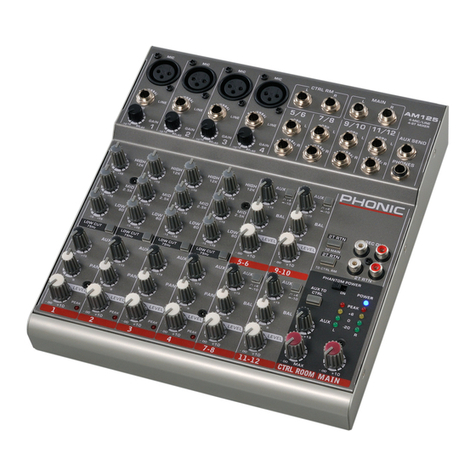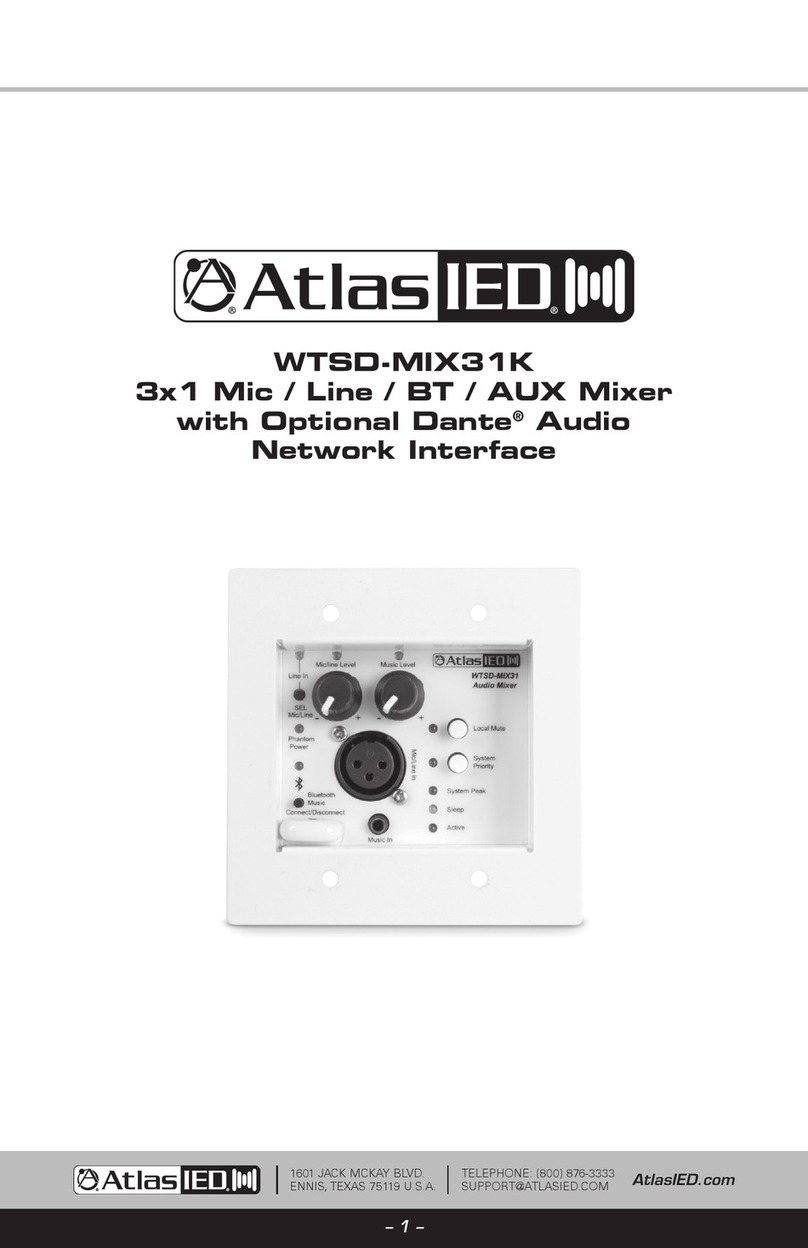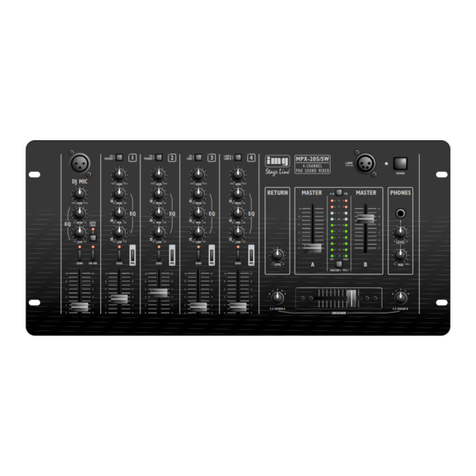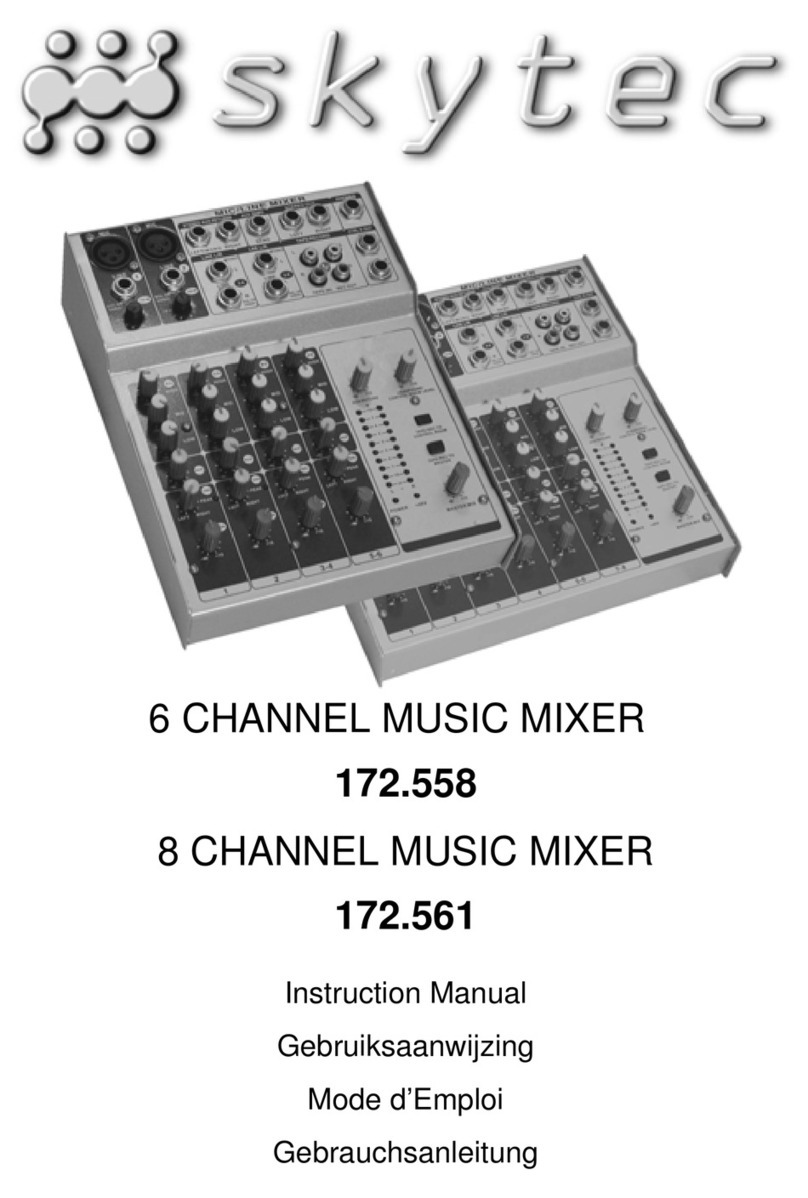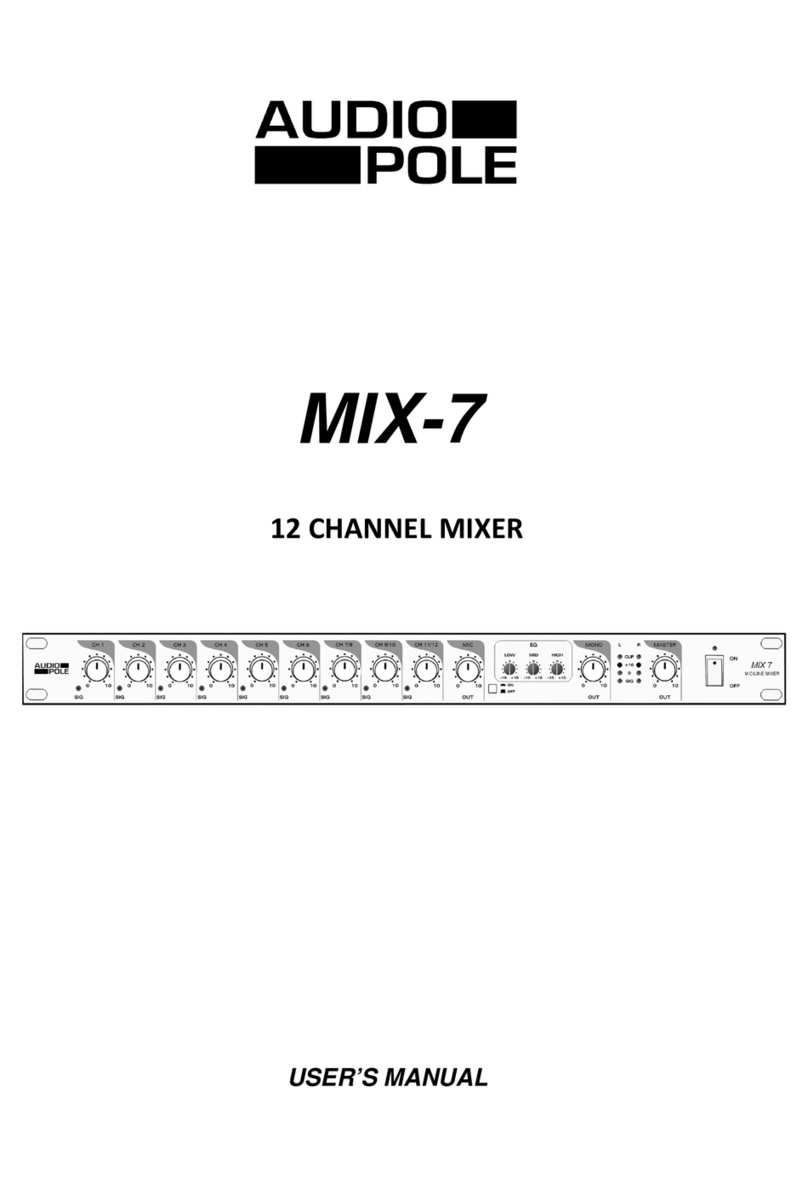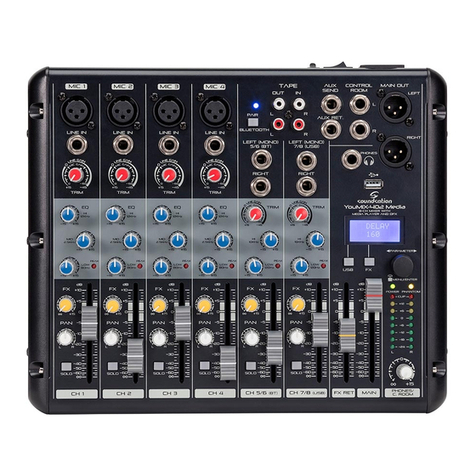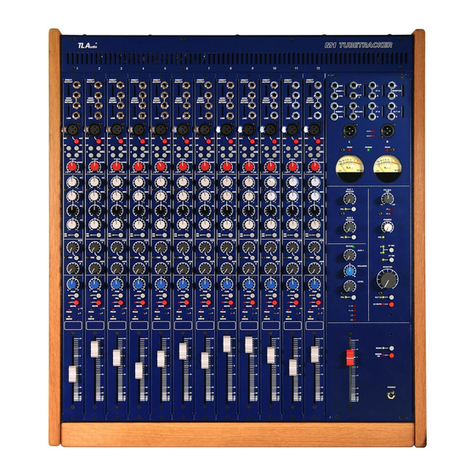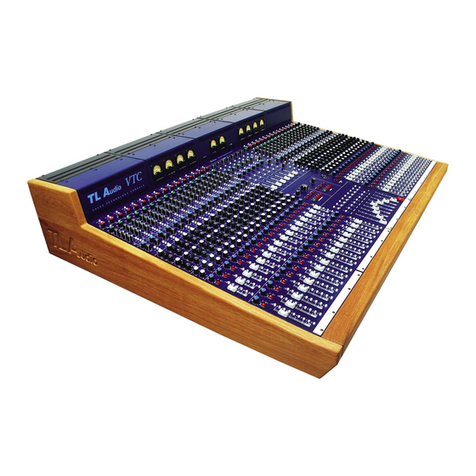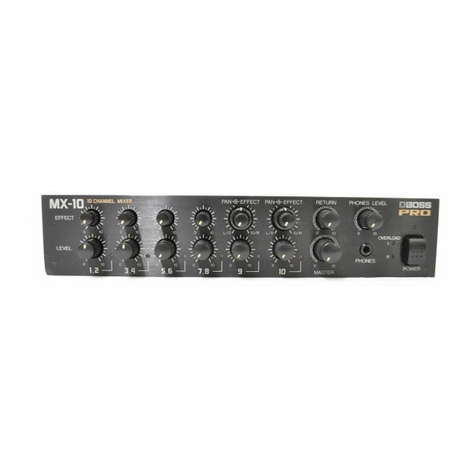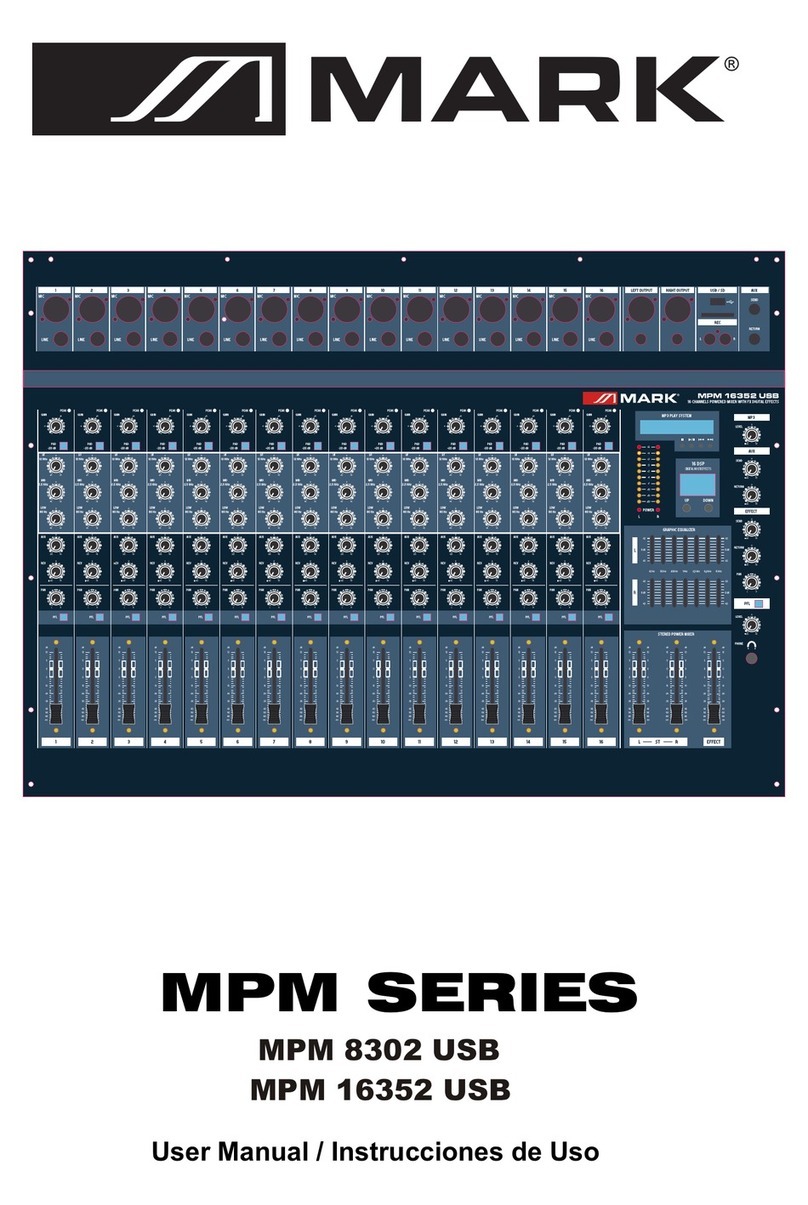MINDPRINT EN-VOICE MK II User manual

MANUAL
www.mindprint.com
MANUAL
1.0
ENGLISHDEUTSCHFRANÇAISITALIANOESPAGñOL
EnVoice_Manual_1.1 15.10.2003 9:15 Uhr Seite 1

MindPrint
®
EN-VOICE
®
MK II
Important:
Please read safety instructions
on page 68 before use!
Wichtig:
Bitte lesen Sie vor der Inbetriebnahme
die Sicherheitshinweise auf Seite 69!
Important :
Avant la mise en service, prière de lire
les consignes de sécurité à la page 69 !
Importante:
Prima di utilizzare lo strumento, leggere
attentamente gli avvisi di sicurezza su pagina 70!
Importante:
¡Antes de la puesta en servicio lea por favor
las indicaciones de seguridaden la página 70!
EnVoice_Manual_1.1 15.10.2003 9:15 Uhr Seite 2

Don´t just dream it ... record it!
In November 1998, a dream harbored by many musicians became reality with the EN-VOICE®
- goodbye demo quality sound, hello professional sounding recordings, achievable and affor-
dable by all. When we set out to develop the EN-VOICE®, we did so with a lofty goal in mind
– to build a better product offering superior sound quality and affording greater ease of use.
And because better products are the product of inspiration and innovation rather than imita-
tion, we aspired to create an original. The EN-VOICE®was that original, an entirely new breed
of device that would make the outboard channel strip a mainstay of home recording.
Often copied yet never matched, this workhorse recording preamp delivers the sonic
goods in thousands of studios all over the world.
After five years of trusty service, it is time our original was adapted to the working habits and
requirements of a rapidly evolving recording market. In the age of the laptop, the modern
producer’s top priorities are - alongside awesome sound - flexibility, mobility and a desktop-
enabled design. Today we’re still aiming for enhanced sound quality and greater ease of use
in our quest to build a better product. Likewise, today we’re still striving for greater flexibility,
mobility, and safety. Enter the EN-VOICE®MK II - another original with features that the world
has never seen in a tube-powered channel strip.
Evolution rather than revolution
If it isn’t broke, don’t fix it: The concept behind the first EN-VOICE®was a stunning success,
so we didn’t change it. Rather than radical redesign, the new design features are the product
of painstaking detailing, particularly in response to our customers’ wishes and suggestions for
improvement. So, how does the successor differ from the first EN-VOICE®? The handling con-
cept, equalizer and revolutionary tube circuitry have remained the same, though the circuitry
has seen some design improvements. The input section, however, was developed anew from
the bottom up and now offers an integrated balanced INSERT, while the compressor now
features eight convenient presets. In addition to redesigning the front panel, we improved
the array and labeling of control features, and endowed the chassis with easily attachable
rack mounts to desktop-enable the device.
Independence Day
The EN-VOICE®MK II is the first channel strip that is a match for laptops when it comes to
mobility. Road-ready courtesy of its USB and automatic switched mode power supply, it goes
where you go, operating reliably when you get there. Though the USB interface is now as
commonplace on the computer as jacks on a mixer, unfortunately, no USB interface to date
has been able to transmit the EN-VOICE®MK II’s sonic qualities loss-free. Thanks to some pio-
neering engineering, this problem has been solved with the optional DI-MOD USB. A further
stride toward total independence is the automatic switched mode power supply, which frees
the EN-VOICE®MK II from the constraints of local mains voltage and protects it against fluc-
tuating current and power surges.
The power unit even enhances tone: Tubes are very sensitive to line voltage fluctuations.
This unit maintains a steady power supply of 250 volts, preventing sound degradation
caused by fluctuating current.
3
MindPrint
®
EN-VOICE
®
MK II
WARRANTY
Register your EN-VOICE®MK II. Use the convenient
ONLINE REGISTRATION at www.mindprint.com
If you are unable to register online, please fill out the
enclosed warranty card completely and mail or fax it
to us. The registration is only valid if the warranty
registration card is filled out and returned to
MindPrint®or the device is registered via Internet
within 30 days of the date of purchase. We are also
interested in learning who uses our devices with
the aim of using this information to help us design
future products. Your data is of course protected by
privacy laws.
Thank you.
MindPrint®
Technical Service
Postfach 1509
D-66595 St. Wendel, Germany
Fax: +49 6851 905 100
ENGLISH
EnVoice_Manual_1.1 15.10.2003 9:15 Uhr Seite 3

MindPrint®– It’s all in the name!
Printing musical ideas onto hard disk in highest sound quality has never been so easy and
convenient. That, in a nutshell, is what the brand name MindPrint means. The combination of
a tube-driven preamp with a USB interface and a switched mode power supply transforms
the EN-VOICE®MK II from a reliable tool into a very personal instrument, totally independent
of operating voltage and computer interface. Wherever you go, it goes with you, giving your
creativity free rein. Everywhere, all the time - even on a trip around the globe.
Here’s wishing you lots of fun and success with the MindPrint EN-VOICE®MK II!
Table of Contents
1. Input Section . . . . . . . . . . . . . . . . . . . . . . . . . . . . 5
2. Equalization . . . . . . . . . . . . . . . . . . . . . . . . . . . . . 9
3. Dynamic Processing . . . . . . . . . . . . . . . . . . . . . . 10
4. Output Section . . . . . . . . . . . . . . . . . . . . . . . . . 13
5. AC Power . . . . . . . . . . . . . . . . . . . . . . . . . . . . . . 13
6. Tips and Tricks . . . . . . . . . . . . . . . . . . . . . . . . . . 14
7. Technical Data . . . . . . . . . . . . . . . . . . . . . . . . . . 63
4
MindPrint
®
EN-VOICE
®
MK II
EnVoice_Manual_1.1 15.10.2003 9:15 Uhr Seite 4

1. Input Section
The EN-VOICE®MK II features a complete input
section consisting of a studio level line input,
a high-ohm instrument input and a low-noise
microphone input with switchable phantom
power for condenser microphones. You can also
retrofit a digital input by installing the DI-MOD
expansion module.
1.1 Microphone Input
Connecting microphones:
On the rear panel of the EN-VOICE®MK II you’ll
find an XLR port for connecting microphones.
It is designed to accept all types of microphones.
Connect condenser microphones to the switcha-
ble 48-volt phantom power port on the front
panel. The EN-VOICE®MK II offers switchable 20-
dB signal dampening for recording very loud
signals. The input impedance is 5 k-ohms.
Handling:
INPUT SELECT: Select the microphone input by
setting the INPUT SELECT button to the MIC
position.
MIC GAIN: Determines the pre-amplification
level within a range of +19 dB to +75 dB.
48 V: Activates phantom power when switched
from the OFF position to the 48V position.
-20 dB: Cuts input levels by 20 dB when switched
from OFF to -20 dB.
5
MindPrint
®
EN-VOICE
®
MK II
CAUTION:
Do not connect line level devices to the microphone
port because this may damage the EN-VOICE®MK II.
Never activate phantom power when unbalanced
microphones or ribbon microphones are connected!
QUESTION
At 10 k-ohms, the microphone input’s impedance is
considerably higher than that of standard micropho-
ne preamps. Why did MindPrint choose to deviate
from the standard value range of 600 to 1000 ohms?
ANSWER
Rather than being constant, the impedance of micro-
phones depends on the frequency. It is not uncom-
mon for impedance spikes to surge up to 1,000 ohms
within microphones’ frequency response range. These
peaks are cut if the microphone preamp’s input
impedance is lower, which of course automatically
changes frequency response. Because these peaks
tend to occur at higher frequencies, this de facto
auto dampening of low-impedance preamp sacrifices
brilliance. Courtesy of its high-impedance design, the
EN-VOICE®MK II can handle extreme peaks, preven-
ting high frequency loss. This ensures microphones,
and particularly dynamic microphones, deliver a
fresher, more natural-sounding signal.
Condenser microphones also sound better because
their amps can operate with a lower load, thereby
generating less noise.
ENGLISH
EnVoice_Manual_1.1 15.10.2003 9:15 Uhr Seite 5

1.2 Instrument Input
Connecting instruments:
A 1/4” jack on the front panel accepts instruments.
Handling:
INPUT SELECT: Select the instrument input by
setting the INPUT SELECT button to LINE/INSTR.
When you plug a cord into the INSTRUMENT IN
jack, the EN-VOICE®MK II automatically switches
to the instrument input, simultaneously deactiva-
ting the line and digital inputs.
LINE GAIN: Determines the amount of cut or
boost within a range of -∞to +22 dB.
1.3 Line Input
Connecting line sources:
Located on the rear panel of the EN-VOICE®MK II,
the line input features two connectors, a balanced
XLR port and a balanced 1/4" jack. You can also
connect unbalanced cables to both inputs.
Handling:
INPUT SELECT: Select the line input by setting
the INPUT SELECT button to LINE/INSTR. It is
only active when the INSTRUMENT input is not
in use!
LINE GAIN: Determines the amount of cut or
boost within a range of -∞to +22 dB.
6
MindPrint
®
EN-VOICE
®
MK II
INPUT SENSITIVITY
This input’s sensitivity was tweaked specifically to
accept guitar and bass signals directly. With an impe-
dance of 1 mega ohm, the instrument input does not
dampen excessively your instrument’s pickup. This
means that the EN-VOICE®MK II is well-suited for use
in an instrument rack.
INFO
The XLR port’s pin assignments comply with the
international IEC 268-12 norm. In accordance with
this norm, pin 1 is the ground, pin 2 carries the posi-
tive signal and pin 3 the negative signal. Be sure to
bridge pin 1 and pin 3 when using an unbalanced
circuit. The stereo 1/4" jack’s tip carries the positive
signal, its ring carries the negative signal, and the
ground circuit is routed via the sleeve. When you
insert an unbalanced mono plug, the input automati-
cally switches to unbalanced operating mode.
EnVoice_Manual_1.1 15.10.2003 9:15 Uhr Seite 6

1.4 Digital Input
Connecting digital sources:
The MindPrint DI-MOD can be installed into a
slot in the rear panel, which lets you connect
digital devices to the EN-VOICE®MK II. You’ll find
the digital interface’s connectors on the actual
DI-MOD. The digital output is wired in parallel to
the analog output.
Handling:
INPUT SELECT: Select the digital input by setting
the INPUT SELECT button to DIGITAL.
LINE GAIN: Determines the amount of cut or
boost within a range of -00 to +22 dB.
1.5 Selecting LED Meter
Modes
This LED meter indicates the level of the input or
output signal, depending on the METER ASSIGN
button’s setting. The yellow LEDs indicate the
EN-VOICE®MK II’s headroom; the red LEDs indi-
cate the saturation level.
Handling:
METER ASSIGN: Switches the level meter so that
it indicates either the input or output signal. For
the record, the meter indicates the input signal
when set to INPUT, and the output signal when
set to OUTPUT.
7
MindPrint
®
EN-VOICE
®
MK II
Optional DI-MOD
If you want to make the most of the sound quality
that the EN-VOICE®MK II has to offer, be sure to
install the DI-MOD. You can view the various models
of DI-MOD at www.mindprint.com
QUESTION
Why is the digital interface not hard-wired into the
device?
ANSWER
The EN-VOICE®MK II is an analog device, and as such
will continue to serve its designated purpose for years
to come. Digital interfaces are subject to change as
digital technology advances. This is why the DI-MOD
is replaceable. Besides, this lets you decide for your-
self which model serves your purposes best.
LED Chain
This meter works like meters found on digital devices
(for example, a DAT recorder): Distortion is imminent
when the meter’s red OVER LED. Though it is advisa-
ble to set the input and output signals to the highest
possible level in order to exploit all the available
headroom, ensure the level remains below 0 dB.
The chain’s top (red) LED should not light up even
at signal peaks.
ENGLISH
EnVoice_Manual_1.1 15.10.2003 9:15 Uhr Seite 7

1.6 Low-Cut Filter
Following the input stage in the signal path is a
(bass cut) filter. Its limiting frequency of 80 Hz
suppresses low-frequency noise such as footsteps
or popping sounds.
Handling:
LOW CUT: Activates the filter.
1.7 Insert
Connecting signal processors:
On the rear panel, you’ll find SEND and a
RETURN jacks enabling you to insert signal pro-
cessors into the EN-VOICE®MK II’s signal path.
Handling:
When you plug a cord into the RETURN jack, the
EN-VOICE®MK II automatically patches the insert
into the signal path at a point located between
the low-cut-filter and the equalizer.
8
MindPrint
®
EN-VOICE
®
MK II
INFO
These connectors are configured as stereo 1/4" jacks.
The positive signal is routed via the tip, the negative
signal via the ring, and the ground via the sleeve.
When you insert an unbalanced mono plug, the
input automatically switches to unbalanced operating
mode.
EnVoice_Manual_1.1 15.10.2003 9:15 Uhr Seite 8

2. Equalization
The equalizer consists of one each semi-parame-
tric band for low and high frequencies as well as
one fully parametric middle frequency band.
All three EQ bands were implemented in the
form of bell filters.
2.1 LF - The Low Frequency
Band
Handling:
ON: Activates the band.
FREQ Hz: Determines the bell curve’s center
frequency within a range of 20 to 300 Hz.
LEVEL dB: Controls the amount of cut or boost
within a range of +/- 15 db.
2.2 MF - The Middle Frequency
Band
Handling:
ON: Activates the band.
FREQ Hz: Determines the bell curve’s center
frequency within a range of 100 Hz to 11 kHz.
LEVEL dB: Controls the amount of cut or boost
within a range of +/- 15 db.
Q: Determines the bell curve’s bandwidth within
a value range of 3 (1/3 octave) to 0.15 (6 octaves).
2.3 HF - The High Frequency
Band
Handling:
ON: This button activates the band.
FREQ kHz: Determines the bell curve’s center
frequency within a range of 1.6 to 22 kHz.
LEVEL dB: Controls the amount of cut or boost
within a range of +/- 15 db.
9
MindPrint
®
EN-VOICE
®
MK II
INFO
Though the LF band’s width (also called quality or
Q-factor) is not variable, you still enjoy flexible EQ
options because frequencies are boosted across a
broad range. Conversely, frequencies are cut in a
very narrow band. This lets you introduce that typical
bottom-end warmth by boosting low frequencies
across the board and pinpoint and suppress undesira-
ble frequencies with precision.
INFO
With its variable frequency range of 100 Hz and 11 kHz,
the mid band extends well into the low and high
ranges. This EQ is your universal sound-sculpting
tool. Its variable bandwidth lets you dial in a Q-factor
between a third (or mediant) and six octaves to target
cuts within a narrow band or equalize frequencies on
a very wide scale.
INFO
At settings above 20 kHz, the filter’s center frequency
lies outside the range of human hearing, and it
responds like a shelving filter. Its quality is fixed,
remaining the same when frequencies are cut and
boost.
ENGLISH
EnVoice_Manual_1.1 15.10.2003 9:15 Uhr Seite 9

3. Dynamic
Processing
The tube compressor gives you the best of both
worlds—the precision of a high-quality semicon-
ductor circuit with the silken sound that only a
vacuum tube can deliver. The circuitry developed
by MindPrint lets you control compression and
tube saturation separately. To achieve the most
inconspicuous compression possible, the
EN-VOICE®MK II works with a soft knee characte-
ristic: When a signal's level nears the threshold
value, the compression rate steadily increases.
When the signal level finally exceeds the threshold
value, it is compressed at the ratio that you have
dialed in. Even when compressed heavily, signals
are gently squeezed rather than crushed when
the signal rises above the threshold.
Handling:
ON: Activates the compressor.
THRESHOLD: Sets the compressor’s threshold
within a range of +2 dB to -28 dB.
The compressor processes all signals whose level
exceeds the threshold value. Depending on the
defined threshold value, the signal may also be
boosted before it is routed to the tube. Signals
whose levels remain below the threshold value
are not processed.
RATIO: Determines the relationship between – or
ratio of – the input and output levels of all signals
exceeding the threshold value. Control range:
1:1 (no compression) to infinite (limiter setting-
the output level cannot be increased any further).
GAIN REDUCTION LED CHAIN: Gives you a
visual indication of the amount that the com-
pressor is trimming off the signal level.
TUBE SATURATION %: Controls the amount of
tube saturation within the compressor for all
signals exceeding the threshold value. This lets
you determine precisely the amount of harmonic
overtones that tube saturation generates.
The control range extends from 0% to 100%.
10
MindPrint
®
EN-VOICE
®
MK II
A WORD ABOUT THE TUBE
The overtones that tubes generate when driven hard
are what makes them so special. While semiconduc-
tors tend to produce harsh, grating distortion, tubes
deliver warm, silken sound that is considered highly
desirable by recordists. Though all-tube circuits deli-
ver a warmer sound, they also have some drawbacks;
for example, they are noisier than solid state circuits.
In the EN-VOICE®MK II, the tube is hard-wired to a
VCA (short for voltage-controlled amplifier, this is the
compressor’s controlling element). Courtesy of this
VCA, the compressor’s response helps shape the tone
generated by the tube. This puts into your hands a
compressor that combines the trademark precision
of a semiconductor circuit with the characteristic
response of all-tube devices. Model 12AX7A tubes are
triodes that are valued for their sonic qualities and
used in many other devices. The popularity of this
model has an agreeable side effect - when a tube
requires a replacement, 12AX7A’s are easy to find
and affordably priced.
BIAS POINT
The threshold value depends on the input level and
equalizer levels. For example, if you turn the input
level well down, you must adjust the Threshold level
accordingly.
LEVEL REDUCTION
A Ratio setting of 2:1 means that the output level
increases by just 1 dB when the input level rises by
2 dB; 5:1 means that it takes a 5 dB boost in input level
to increase the output level by 1 dB. Note that you
don’t have to reduce the gain manually because the
EN-VOICE MK II adjusts the overall level automatically.
TUBE SATURATION
A good analogy for tube saturation is the behavior of
a guitar string. Both generate a fundamental frequen-
cy and a series of harmonics. In the case of the string,
harmonics are the frequencies produced by half the
string, a third, a quarter and so forth. In both cases,
the relative levels of harmonics are decisive in sha-
ping tone. It takes the right mix to create a signal
that pleases the human ear.
INFO
High-energy low-frequency signals can cause the
compressor to generate undesirable pumping effects.
For this reason, the compressor is equipped with a fil-
ter designed to make it is less responsive to low fre-
quencies, yielding the kind of natural-sounding com-
pression our ears are accustomed to hearing. Because
this design simulates a natural function of the human
ear, this filter circuit enhances the tone of almost
every signal.
Output
Input
1:1
∞
Threshold
Compression
Output
Input
normal
Soft Knee Characteristic
EnVoice_Manual_1.1 15.10.2003 9:15 Uhr Seite 10

TUBE SAT: Indicates the degree of distortion in
threes levels - green, yellow and red. Overtones
are hardly audible when the meter is in the
green. When in the yellow, saturation is clearly
audible. When in the red, you will hear overtones
as distortion.
FILTER: Switches the compressor’s side chain
filter on. When the filter is activated, lower
frequencies have less influence on compression,
which yields a more balanced sonic image,
particularly in the mid and high frequency ranges.
Because the filter is wired into the control circuitry
rather than the signal path, it influences the
compressor’s response rather than the actual
sound of the signal.
Type: low-cut, shelving
Corner frequency: 300 Hz
Slope: 6 dB/octave
COMPRESSION MODE: Selects eight presets for
the compressor’s program-dependent control
time tracking.
11
MindPrint
®
EN-VOICE
®
MK II
Adaptive Response Circuit
The EN-VOICE®MK II is equipped with an Adaptive
Response circuit developed by MindPrint®. It works
with several mutually influencing time constants,
using an intelligent attack and release automatism to
prevent undesirable side effects. The default control
time changes adaptively so that the compressor
responds faster to brief signals and slower to sustai-
ned signals. A standard compressor’s response to
dense, powerful audio material is to cut signal peaks
radically, which results in a pumping effect. This
adaptive circuit offers an additional mechanism that
catches fast impulses regardless of the basic compres-
sor setting.
INFO
The differences between presets are most clearly
audible at low Threshold and high Ratio settings.
The easiest way to find the best setting is to twist
these two knobs to the far right and gradually back
them off until you achieve the desired effect. Setting
the knobs to the 12-clock position generally yields
inconspicuous results. If you want a more pronounced
effect, turn the Threshold down (twist the knob
clockwise!) and then adjust the Ratio knob.
ENGLISH
EnVoice_Manual_1.1 15.10.2003 9:15 Uhr Seite 11

Vocal 1, Dynamic Voice: This preset offers neutral
dynamic processing, gently and unobtrusively
boosting loudness and density.
Vocal 2, Voice Over: This preset offers very loud-
sounding compression to beef up the sound of
the natural voice.
Vocal 3, Classical Voice: Rather than changing
the human voice’s natural character, this preset
gently balances out differences in level.
Guitar 1, Funky: This one’s perfect for emphasi-
zing the crisp attack of a funky guitar, boosting
signal level and pushing the track to the fore-
front of the mix.
Guitar 2, Overdrive: This preset fattens up distor-
ted riffs, adding punch to single-note lines and
rounding out jazz chords.
Bass 1, Slap: Tweaked for slap styles, this
preset adds density to the bass signal ensuring
a smoother sound in the mix without introducing
undesirable side effects.
Bass 2, Fingered: This preset boosts string attack,
making the instrument feel more responsive
while recording and the bass track cut through
the mix better.
Percussive: Fine-tuned specifically for recording
drum and percussion sounds, this preset elicits
very fast compressor response while retaining a
natural-sounding attack.
MindPrint
®
EN-VOICE
®
MK II
V1
It is best suited for soft, natural sounds typical of very
dynamic musical styles, for example, jazz or songs
played principally on acoustic instruments.
V2
It is excellent for elaborately arranged pop vocals and
advertising voice-overs. Low Threshold and high
Ratio settings make vocal tracks jump right out of
the mix.
TIP
The names of the presets are merely something to go
by. When searching for the right sound, nothing pre-
vents you from processing a vocal track with a preset
intended for a guitar or bass track. The same holds
true for every signal source imaginable, from a spea-
ker to a saxophone or synth. Feel free to experiment.
The table depicts recommended settings for TUBE
SAT, RATIO and FILTER parameters.
Preset Description Attack Release TubeSat Ratio Filter
V1: Vocal clear, standard med. short 25% 2.5 on
V2: Vocal fat, "analog" long short 50% 3.5 on
V3: Vocal natural short med. 25% 1.7 on
G1: Guitar percussive, funky med. long 25% 1.7 on
G2: Guitar soft med. short 50% 1,7 off
B1: Bass percussive, slap long med. 25% 1.7 off
B2: Bass gritty short short 75% 2.5 off
P : Percussion fat and punchy short short 0% 5.0 on
12
EnVoice_Manual_1.1 15.10.2003 9:15 Uhr Seite 12

4. Output Section
4.1 OUTPUT
Connecting outboard gear:
The balanced XLR output serves as a recording
out for connected recording systems, mixers or
external converters. The balanced 1/4” jack output
is an analog monitor output. The two outputs
may be used simultaneously.
Handling:
OUTPUT: Determines output volume within
a range of -∞to +8 dB. Unity gain is achieved
at the 0 setting.
4.2 BYPASS
Handling:
BYPASS: Removes all of the EN-VOICE®MK II’s
processing components and the Output knob
from the signal path.
5. AC Power
The EN-VOICE®MK II is connected to a wall outlet
or mains supply via a standard power cable con-
nected to the AC power socket.
If you encounter a ground loop, you can use the
Ground Lift switch to sever the signal ground
from the device's chassis ground. A ground loop
is pretty easy to identify - the device emits
annoying hum. In this case, set this switch to the
position where the noise is canceled out.
13
MindPrint
®
EN-VOICE
®
MK II
INFO
If you insert an unbalanced cord equipped with 1/4”
plugs into the output, say to connect a monitoring
system, the signal patched to the XLR port will also
be unbalanced. If you have no choice but to use an
unbalanced monitor signal but require a balanced
signal from the XLR port, you can employ a standard
unbalanced 1/4” jack cord for your monitor and solder
a stereo 1/4” jack plug to the end of cord end to be
inserted into the EN-VOICE®MK II’s output. Do not
wire a terminal to the RING. The TIP carries the signal,
the SLEEVE is the ground, and the signal of the XLR
socket remains balanced.
TIP
As described in section 1.5 Selecting LED Meter
Modes, you can assign the level meter to the input
oroutput. This means that the meter indicates either
the post preamp level or the output level of the
EN-VOICE®MK II.
CAUTION
Depending on settings, there may be a considerable
difference in the levels of the processed and original
signals. BYPASS serves principally to A/B or compare
the processed and original signals. If you want to use
the Output knob as an “alternative” volume control,
it is a good idea to switch off the individual proces-
sing stages for purposes of comparison.
ENGLISH
EnVoice_Manual_1.1 15.10.2003 9:15 Uhr Seite 13

6 Tips and Tricks
6.1 Switching noise
All of the EN-VOICE®MK II On buttons are real
hardware switches. This means that, rather than
just being deactivated, the processing stages are
actually removed from the signal path. While
removing unnecessary stages from the circuit
enhances audio quality, these switches sometimes
cause undesirable clicking or popping noises,
which are produced by sudden surges in ampli-
tude. Your best bet is to forget about switching
individual equalizer bands or the entire effects
chain on and off during recording or processing
with the EN-VOICE®MK II.
6.2 Over-the-top distortion
The tube compressor acts upon all signals that lie
above the threshold value. Moreover, the satura-
tion of the tube will fluctuate depending on how
high the signal level is. To keep the saturation
fairly even, the compressor should be used to
keep the signal level as steady as possible. If you
dial in a low threshold value and a high satura-
tion level, the tube will be driven hard enough
to produce fairly heavy distortion at signal peaks.
In this case, you should increase the compression
ratio to reduce these signal peaks. If you don't
want quite this much signal processing, you
should dial in lower threshold and saturation
values.
6.3 The EN-VOICE®MK II
in Live Applications
Although the EN-VOICE®MK II was primarily
developed for recording purposes, it actually
wears many hats - you'll find that it is an excellent
tool for live applications. If you are the proud
owner of a guitar rack system, you can patch it
in post-preamp and pre-power amp to compress
your instrument's signal. When you play gigs that
you can't be bothered to tote your entire rig to,
simply plug your guitar into the instrument input
and feed the output signal directly to the mixing
console; the EN-VOICE®MK II thus becomes a con-
venient tube DI box. For processing vocals, you
can patch the EN-VOICE®MK II into a mixer insert
just as you would an effects device, so that the
amplified sound of your voice enjoys the benefits
of those desirable tube characteristics.
14
MindPrint
®
EN-VOICE
®
MK II
EnVoice_Manual_1.1 15.10.2003 9:15 Uhr Seite 14

7. Technical Specifications
All data related to levels is referenced to 0 dBu (0.775V RMS).
LINE IN:
Connections: XLR (pin 1 = ground; pin 2 = +; pin 3 = -) and
1/4" (tip = +; ring = -; sleeve = ground)
Input type: electronically balanced and floating
Input impedance: 44 kohms
Min. Input level: -5.4 dBu @ Line Gain +22 dB
Max. Input level: +20.5 dBu @ Line Gain <-10 dB
Sensitivity: 0 dB
Gain: ∞- to +22.5 dB
MIC IN:
Connection type: XLR (pin 1 = ground; pin 2 = +; pin 3 = -)
Input type: electronically balanced and floating
Input impedance: 10 kohms
Min. Input level: -55.4 dBu @-20 dB Pad OFF
Max. Input level: 25 dBu @-20 dB Pad ON
Gain: +25 to +72 dB
INSTRUMENT IN:
Connection type: 1/4" (tip = +; sleeve = -)
Input type: unbalanced
Input impedance: 470 kohms
Min. Input level: -11 dBu @ Line Gain +22 dB
Max. Input level: +23.5 dBu @ Line Gain <-15 dB
Sensitivity: 3 dB
DIGITAL IN:
only with optional DI-MOD
INSERT RETURN
Connections: 1/4" (tip = +; ring = -; sleeve = ground)
Input type: electronically balanced and floating
Input impedance: 55 kohms
Max. Input level: +17.5 dBu
Sensitivity: 0 dB
BASS CUT:
Switchable: on or off
Shelving frequency: 80 Hz
Slope: 12 dB/ oct.
BASS EQ:
Type: Bell
Switchable: on or off
Center frequency: adjustable from 20 Hz to 300 Hz
Boost: 15 dB
Boost slope: 6 dB/ oct.
Cut: 15 dB
Cut slope: 12 dB/ oct.
MID EQ:
Type: Bell
Switchable: on or off
Center frequency: adjustable from 100 Hz to 11 kHz
Boost: 15 dB
Cut: 15 dB
Slope: 3 dB/oct. - 24 dB/oct. (dependent on setting of Q-factor)
HIGH EQ:
Type: Bell
Switchable: on or off
Center frequency: adjustable from 11 kHz to 22 kHz
Boost: 15 dB
Cut: 15 dB
Slope: 6 dB/ oct.
COMPRESSOR
Switchable: on or off
TUBE SAT:
Harmonic distortion: adjustable between 1% and 100%
THRESHOLD: adjustable between +2 dB and -28 dB
COMPRESSION: adjustable from 1:1 to Åá:1
Attack/Release: switchable, 8 Presets
FILTER:switchable on or off, LOW-CUT 300 Hz, 6 dB/octave
INSERT SEND:
Connections: 1/4" (tip = +; ring = -; sleeve = ground)
Type Output: electronically balanced and floating
Output impedance: 220 ohms
Max. output level: +19 dBu
LINE OUT:
Connections: XLR (1 = ground; 2 = +; 3 = -) and
1/4" (tip = +; ring = -; sleeve = ground)
Type Output: electronically balanced and floating
Output impedance: 220 ohms
Max. output level: +19 dBu
Gain: -∞to +6 dB
BYPASS:
switchable: on or off
max. current draw: 132 mA ( 170 mA mit DI-MOD ) @ 240 volts AC
max. power cons: 44 VA
Primary Fuse: T 1.25 A (slow blow)
Dimensions:
Width: 482 mm (19")
Height: 44 mm (1 3/4")
Depth: 238 mm (9 2/5")
Weight: 3.44 kg (7 3/5 lbs.)
OPTIONS:
DI-MOD USB:2channels AD/DA, up to 24 bits, 96 kHz,
110 dB (a) dynamic range, USB IN/OUT,
Additional S/PDIF Out, Stereo Monitor Out,
Zero Latency Monitoring
DS 1-P: Perspex Desktop Stand , dimensions: 260 x 90 x 8 mm
63
MindPrint
®
EN-VOICE
®
MK II
Technical Data
EnVoice_Manual_1.1 15.10.2003 9:15 Uhr Seite 63

7. Technische Daten
Alle Daten beziehen sich auf einen Referenzpegel von 0 dBu (0.775V RMS).
LINE IN:
Bauart: XLR (pin 1 = Masse; pin 2 = +; pin 3 = -) und
1/4" (Tip = +; Ring = -; Schaft = Masse)
Eingang: elektronisch symmetriert
Eingangsimpedanz: 44 kohm
Min. Eingangspegel: -5.4 dBu @ Line Gain +22 dB
Max. Eingangspegel: +20.5 dBu @ Line Gain <-10 dB
Empfindlichkeit: 0 dB
Verstärkung: -∞to +22.5 dB
MIC IN:
Bauart: XLR (pin 1 = ground; pin 2 = +; pin 3 = -)
Eingang: elektronisch symmetriert
Eingangsimpedanz: 10 kohm
Min. Eingangspegel: -55.4 dBu @-20 dB Pad OFF
Max. Eingangspegel: 25 dBu @-20 dB Pad ON
Verstärkung: +25 to +72 dB
INSTRUMENT IN:
Bauart: 1/4" (tip = +; sleeve = -)
Eingang: unsymmetrisch
Eingangsimpedanz: 470 kohm
Min. Eingangspegel: -11 dBu @ Line Gain +22 dB
Max. Eingangspegel: +23.5 dBu @ Line Gain <-15 dB
Empfindlichkeit: 3 dB
DIGITAL IN:
nur mit optionalem DI-MOD
INSERT RETURN
Bauart: 1/4" (Tip = +; Ring = -; Schaft = Masse)
Eingang: elektronisch symmetriert
Eingangsimpedanz: 55 kohm
Max. Eingangspegel: +17.5 dBu
Empfindlichkeit: 0 dB
BASS CUT:
Schaltbar: An/Aus
Einsatzfrequenz: 80 Hz
Flankensteilheit: 12 dB/ Oktave.
BASS EQ:
Typ: Glockenfilter
Schaltbar: An/Aus
Center-Frequenz: einstellbar von 20 Hz bis 300 Hz
Verstärkung: 15 dB
Flankensteilheit: 6 dB/ Oktave.
Absenkung: 15 dB
Flankensteilheit: 12 dB/ Oktave.
MID EQ:
Typ: Glockenfilter
Schaltbar: An/Aus
Center-Frequenz: einstellbar von 100 Hz bis 11 kHz
Verstärkung: 15 dB
Absenkung: 15 dB
Flankensteilheit: 3 dB/ Oktave - 24 dB/ Oktave. (einstellbar, Q-Factor)
HIGH EQ:
Type: Glockenfilter
Switchable: on or off
Center-Frequenz: einstellbar von 11 kHz bis 22 kHz
Verstärkung: 15 dB
Absenkung: 15 dB
Flankensteilheit: 6 dB/ oct.
COMPRESSOR
Schaltbar: An/Aus
TUBE SAT:
Harmonische Verzerrung: einstellbar von 1% bis 100%
THRESHOLD: einstellbar von +2 dB bis -28 dB
COMPRESSION: einstellbar von 1:1 bis Åá:1
Attack/Release: schaltbar, 8 Presets
FILTER: schaltbar: An/Aus, LOW-CUT 300 Hz, 6 dB/ Oktave
INSERT SEND:
Bauart: 1/4" (Tip = +; Ring = -; Schaft = Masse)
Ausgang: elektronisch symmetriert
Ausgangsimpedanz: 220 ohm
Max. Ausgangspegel: +19 dBu
LINE OUT:
Bauart: XLR (1 = Masse; 2 = +; 3 = -) und
1/4" (Tip = +; Ring = -; Schaft = Masse)
Ausgang: elektronisch symmetriert
Ausgangsimpedanz: 220 ohm
Max. Ausgangspegel: +19 dBu
Verstärkung: -∞to +6 dB
BYPASS:
Schaltbar: An/Aus
max. Stromaufnahme: 132 mA ( 172 mA mit DI-MOD ) @ 240 Volt AC
max. Leistungsaufnahme: 44 VA
Primärsicherung: T 1.25 A (träge)
Maße:
Breite: 482 mm (19")
Höhe: 44 mm (1 3/4")
Tiefe: 238 mm (9 2/5")
Gewicht: 3.44 kg (7 3/5 lbs.)
OPTIONS:
DI-MOD USB:2Kanäle AD/DA, bis zu 24 Bit, 96 kHz
110 dB (a) Dynamikumfang, USB IN/OUT,
zusätzlich S/PDIF Out, Stereo Monitor Out,
Zero Latency Monitoring
DS 1-P: Plexiglas Desktop Stand, Maße: 260 x 90 x 8 mm
64
MindPrint
®
EN-VOICE
®
MK II
EnVoice_Manual_1.1 15.10.2003 9:15 Uhr Seite 64

Caractéristiques techniques
Toutes les données se basent sur un niveau de référence de 0 dBu (0,775 V RMS).
LINE IN :
Type de connexion : XLR (borne 1 = masse ; borne 2 = + ; borne 3 = -)
et 1/4" (pointe = + ; anneau = - ; axe = masse)
Entrée : électroniquement symétrique
Impédance d'entrée : 44 kohms
Niveau d'entrée min. : -5,4 dBu pour Line Gain +22 dB
Niveau d'entrée max. : +20,5 dBu pour Line Gain <-10 dB
Sensibilité : 0 dB
Amplification : -∞à +22,5 dB
MIC IN :
Type de connexion : XLR (borne 1 = masse ; borne 2 = + ; borne 3 = -)
Entrée : électroniquement symétrique
Impédance d'entrée : 10 kohms
Niveau d'entrée min. : -55,4 dBu pour -20 dB Pad OFF
Niveau d'entrée max. : 25 dBu pour -20 dB Pad ON
Amplification : de +25 à +72 dB
INSTRUMENT IN :
Type de connexion : 1/4" (pointe = + ; tige = -)
Entrée : asymétrique
Impédance d'entrée : 470 kohms
Niveau d'entrée min. : -11 dBu pour Line Gain +22 dB
Niveau d'entrée max. : +23,5 dBu pour Line Gain <-15 dB
Sensibilité : 3 dB
DIGITAL IN :
uniquement avec DI-MOD (en option)
INSERT RETURN :
Type de connexion : 1/4" (pointe = + ; anneau = - ; axe = masse)
Entrée : électroniquement symétrique
Impédance d'entrée : 55 kohms
Niveau d'entrée max. : +17,5 dBu
Sensibilité : 0 dB
BASS CUT :
Commutable : on/off
Fréquence d'attaque : 80 Hz
Pente du signal : 12 dB/octave
BASS EQ :
Type : filtre à cloche
Commutable : on/off
Fréquence centrale : réglable de 20 Hz à 300 Hz
Amplification : 15 dB
Pente du signal : 6 dB/octave
Abaissement : 15 dB
Pente du signal : 12 dB/octave
MID EQ :
Type : filtre à cloche
Commutable : on/off
Fréquence centrale : réglable de 100 Hz à 11 kHz
Amplification : 15 dB
Abaissement : 15 dB
Pente du signal : de 3 dB/octave à 24 dB/octave (réglable, facteur Q)
HIGH EQ :
Type : filtre à cloche
Commutable : on/off
Fréquence centrale : réglable de 11 kHz à 22 kHz
Amplification : 15 dB
Abaissement : 15 dB
Pente du signal : 6 dB/octave
COMPRESSEUR
Commutable : on/off
TUBE SAT :
Distorsion harmonique : réglable de 1% à 100%
THRESHOLD (seuil) : réglable de +2 dB à -28 dB
COMPRESSION : réglable de 1:1 à Åá:1
Attaque/relâchement : commutable, 8 presets
FILTRE : commutable : on/off, passe haut 300 Hz, 6 dB/octave
INSERT SEND :
Type de connexion : 1/4" (pointe = + ; anneau = - ; axe = masse)
Sortie : électroniquement symétrique
Impédance de sortie : 220 ohms
Niveau de sortie max. : +19 dBu
LINE OUT :
Type de connexion : XLR (1 = masse ; 2 = + ; 3 = -)
et 1/4" (pointe = + ; anneau = - ; axe = masse)
Sortie : électroniquement symétrique
Impédance de sortie : 220 ohms
Niveau de sortie max. : +19 dBu
Amplification : de -∞à +6 dB
BYPASS :
Commutable : on/off
Consommation de
courant max. : 132 mA (172 mA avec DI-MOD ) pour 240 volts CA
Puissance absorbée max. : 44 VA
Fusible primaire : T 1,25 A )fusible temporisé)
Dimensions :
largeur : 482 mm ;
hauteur : 44 mm ;
profondeur : 238 mm
Poids : 3,44 kg
Options
USB DI- MOD : 2 canaux AN/NA, jusqu’à 24 bits, 96 kHz
Spectre dynamique: 110 dB (a) USB IN/OUT,
S/PDIF Out supplémentaire, Moniteur Stereo Out,
surveillance en temps réel
DS 1-P : stand desktop en plexiglas,
dimensions : 260 x 90 x 8 mm
65
MindPrint
®
EN-VOICE
®
MK II
Technical Data
EnVoice_Manual_1.1 15.10.2003 9:15 Uhr Seite 65

66
MindPrint
®
EN-VOICE
®
MK II
Caratteristiche Tecniche
I valori seguenti si intendono rispetto a un livello di riferimento
di 0 dBu (0,775V RMS).
LINE IN:
Tipo di costruzione: XLR (pin 1 = massa; pin 2 = +; pin 3 = -)
e 1/4" (punta = +; annello = -; manico = massa)
Ingresso: simmetria elettronica
Impedenza di ingresso: 44 kOhm
Minimo livello di ingresso: -5,4 dBu @ Line Gain +22 dB
Massimo livello di ingresso: +20.5 dBu @ Line Gain <-10 dB
Sensibilità: 0 dB
Amplificazione: -∞a +22.5 dB
MIC IN:
Tipo di costruzione: XLR (pin 1 = massa; pin 2 = +; pin 3 = -)
Ingresso: simmetria elettronica
Impedenza di ingresso: 10 kOhm
Minimo livello di ingresso: -55.4 dBu @-20 dB Pad OFF
Massimo livello di ingresso: 25 dBu @-20 dB Pad ON
Amplificatzione: +25 a +72 dB
INSTRUMENT IN:
Tipo di costruzione: 1/4" (punta = +; manico = -)
Ingresso: assimmetrico
Impedenza di ingresso: 470 kOhm
Minimo livello di ingresso: -11 dBu @ Line Gain +22 dB
Massimo livello di ingresso: +23,5 dBu @ Line Gain <-15 dB
Sensibilità: 3 dB
DIGITAL IN:
soltanto con module opzionale DI-MOD
INSERT RETURN
Tipo di costruzione: 1/4" (punta = +; annello = -; manico = massa)
Ingresso: simmetria elettronica
Impedenza di ingresso: 55 kOhm
Massimo livello di ingresso: +17.5 dBu
Sensibilità: 0 dB
BASS CUT:
Commutabile: acceso/spento
Frequenza di lavoro: 80 Hz
Tasso di accrescimento: 12 dB/ottava
BASS EQ:
Tipo: filtro a campana
Commutabile: acceso/spento
Frequenza centrale: regolabile da 20 Hz a 300 Hz
Aumento: 15 dB
Tasso di accrescimento: 6 dB/ottava
Reduzione: 15 dB
Tasso di accrescimento: 12 dB/ottava
MID EQ:
Tipo: filtro a campana
Commutabile: acceso/spento
Frequenza centrale: regolabile da 100 Hz a 11 kHz
Aumento: 15 dB
Reduzione: 15 dB
Tasso di accrescimento: 3 dB/ottava a 24 dB/ottava (regolabile, fattore Q)
HIGH EQ:
Tipo: filtro a campana
Commutabile: acceso/spento
Frequenza centrale: regolabile da 11 kHz a 22 kHz
Aumento: 15 dB
Reduzione: 15 dB
Tasso di accrescimento: 6 dB/ottava
COMPRESSOR
Commutabile: acceso/spento
TUBE SAT:
Distorsione armonica: regolabile da 1% a 100%
THRESHOLD: regolabile da +2 dB a -28 dB
COMPRESSION: regolabile da 1:1 a Åá:1
Attack/Release: commutabile, 8 preset
FILTER: commutabile: acceso/spento, LOW-CUT 300 Hz, 6dB/ottava
INSERT SEND:
Tipo di costruzione: 1/4" (punta = +; annello = -; manico = massa)
Uscita: simmetria elettronica
Impedenza di uscita: 220 ohm
Massimo livello di uscita: +19 dBu
LINE OUT:
Tipo di costruzione: XLR (1 = massa; 2 = +; 3 = -) e
e 1/4" (punta = +; annello = -; manico = massa)
Uscita: simmetria elettronica
Impedenza di uscita: 220 ohm
Massimo livello di uscita: +19 dBu
Aumento: -∞a +6 dB
BYPASS:
Commutabile: acceso/spento
Massimo assorbimento
di corrente: 132 mA ( 172 mA con DI-MOD ) @ 240 Volt AC
Massimo assorbimento
di potenza: 44 VA
Fusibile principale: T 1,25 A (ritardato)
Dimensioni:
larghezza: 482 mm (19")
altezza: 44 mm (1 3/4")
profondità: 238 mm (9 2/5")
Peso: 3,44 kg (7 3/5" lbs.)
MODULI OPZIONALI
DI-MOD USB: 2 canali AD/DA, fino a 24 Bit, 96 kHz
Spettro dinamico: 110 dB (a), USB IN/OUT,
in addizione S/PDIF Out, Stereo Monitor Out,
Zero Latency Monitoring
DS 1-P: Desktop-stand in plexiglas,
dimensioni: 260 x 90 x 8 mm
EnVoice_Manual_1.1 15.10.2003 9:15 Uhr Seite 66

67
MindPrint
®
EN-VOICE
®
MK II
Datos técnicos
Todos los datos son respecto al nivel de referencia de 0 dBu (0.775V RMS)
LINE IN:
Tipo constructivo: XLR (pin 1 = Masa; pin 2 = +; pin 3 = -)
yd 1/4" (Tipo = +; Anillo = -; Mango = Masa)
Entrada: electrónicamente simetrizada
Impedancia de entrada: 44 kohmios
Nivel de entrada mín: -5.4 dBu @ ganancia línea +22 dB
Nivel de entrada max.: +20.5 dBu @ ganancia línea -10 dB
Sensibilidad: 0 dB
Amplificación: -∞to +22.5 dB
MIC IN:
Tipo constructivo: XLR (pin 1 = masa; pin 2 = +; pin 3 = -)
Entrada: electrónicamente simetrizada
Impedancia de entrada: 10 kohmios
Nivel de entrada mín: -55.4 dBu @-20 dB Pad OFF
Nivel de entrada max.: 25 dBu @-20 dB Pad ON
Amplificación: +25 a +72 dB
INSTRUMENT IN:
Tipo constructivo: 1/4" (Tipo = +; manguito = -)
Entrada: asimétrico
Impedancia de entrada: 470 kohmios
Nivel de entrada mín: -11 dBu @ ganancia línea +22 dB
Nivel de entrada max.: +23.5 dBu @ ganancia línea -15 dB
Sensibilidad: 3 dB
DIGITAL IN:
Sólo con DI-MOD opcional
INSERT RETURN
Tipo constructivo: 1/4" (Tipo = +; Anillo = -; Mango = Masa)
Entrada: electrónicamente simetrizada
Impedancia de entrada: 55 kohmios
Nivel de entrada max.: +17.5 dBu
Sensibilidad: 0 dB
BASS CUT:
Conmutable: Encendido/ Apagado
Frecuencia de aplicación: 80 Hz
Pendiente de flancos: 12 dB/ Octavos.
BASS EQ:
Tipo: Filtro de campana
Conmutable: Encendido/ Apagado
Frecuencia central: ajustable de 20 Hz hasta 300 Hz
Amplificación: 15 dB
Pendiente de flancos: 6 dB/ Octavos.
Descenso: 15 dB
Pendiente de flancos: 12 dB/ Octavos.
MID EQ:
Tipo: Filtro de campana
Conmutable: Encendido/ Apagado
Frecuencia central: ajustable de 100 Hz hasta 11 kHz
Amplificación: 15 dB
Descenso: 15 dB
Pendiente de flancos: 3 dB/ Octavos - 24 dB/ Octavos. (ajustable,
Factor Q)
HIGH EQ:
Tipo: Filtro de campana
Conmutable: on o off
Frecuencia central: ajustable de 11 kHz hasta 22 kHz
Amplificación: 15 dB
Descenso: 15 dB
Pendiente de flancos: 6 dB/ oct.
COMPRESOR
Conmutable: Encendido/ Apagado
TUBE SAT:
Distorsión armónica: ajustable de 1% hasta 100%
THRESHOLD: ajustable de +2 dB hasta -28 dB
COMPRESION: ajustable de 1:1 hasta Åá:1
Attack/Release: conmutable, 8 Presets
FILTRO:
Conmutable: Encendido / apagado, LOW-CUT 300 Hz,
6 dB/ Octavos
INSERT SEND:
Tipo constructivo: 1/4" (Tipo = +; Anillo = -; Mango = Masa)
Salida: electrónicamente simetrizada
Impedancia de salida: 220 ohmios
Nivel de salida max.: +19 dBu
LINE OUT:
Tipo constructivo: XLR (1 = Masa; 2 = +; 3 = -) y
yd 1/4" (Tipo = +; Anillo = -; Mango = Masa)
Salida: electrónicamente simetrizada
Impedancia de salida: 220 ohmios
Nivel de salida max.: +19 dBu
Amplificación: -∞to +6 dB
BYPASS:
Conmutable: Encendido / apagado
Consumo de corriente máx: 132 mA ( 172 mA con DI-MOD ) @ 240 Voltios AC
Consumo máx de potencia: 44 VA
Fusible primario: T 1.25 A (lento)
Dimensión:
Ancho: 482 mm (19")
Alto: 44 mm (1 3/4")
Profundidad: 238 mm (9 2/5")
Peso: 3.44 kg (7 3/5 lbs.)
OPCIONES
DI-MOD USB: 2 canales AD/DA, de hasta 24 Bit, 96 kHz
110 dB (a) volumen dinámico, USB IN/OUT,
además S/PDIF Out, Monitor estereo Out,
Zero Latency Monitoring
DS 1-P: Expositor Plexiglás, mostrador ,
Dimensiones: 260 x 90 x 8 mm
Technical Data
EnVoice_Manual_1.1 15.10.2003 9:15 Uhr Seite 67

IMPORTANT SAFETY INSTRUCTIONS
BEFORE CONNECTING, READ INSTRUCTIONS
• Read all of these instructions!
• Save these instructions for later use!
• Follow all warnings and instructions marked on the product!
• Do not use this product near water, i.e. bathtub, sink, swimming pool, wet basement, etc.
• Do not place this product on an unstable cart, stand or table. The product may fall, causing
serious damage to the product or to persons!
• Slots and openings in the cabinet and the back or bottom are provided for ventilation; to
ensure reliable operation of the product and to protect it from overheating, these openings
must not be blocked or covered. This product should not be placed in a built-in installation
unless proper ventilation is provided.
• This product should not be placed near a source of heat such as a stove, radiator, or
another heat producing amplifier.
• Use only the supplied power supply or power cord. If you are not sure of the type of power
available, consult your dealer or local power company.
• Do not allow anything to rest on the power cord. Do not locate this product where persons
will walk on the cord.
• Never break off the ground pin on the power supply cord.
• Power supply cords should always be handled carefully. Periodically check cords for cuts or
sign of stress, especially at the plug and the point where the cord exits the unit.
• The power supply cord should be unplugged when the unit is to be unused for long periods
of time.
• If this product is to be mounted in an equipment rack, rear support should be provided.
• This product should be used only with a cart or stand that is recommended by MindPrint®.
• Never push objects of any kind into this product through cabinet slots as they may touch
dangerous voltage points or short out parts that could result in risk of fire or electric shock.
Never spill liquid of any kind on the product.
• Do not attempt to service this product yourself, as opening or removing covers may expose
you to dangerous voltage points or other risks. Refer all servicing to qualified service
personnel.
• Unplug this product from the wall outlet and refer servicing to qualified service personnel
under the following conditions:
• When the power cord or plug is damaged or frayed.
• If liquid has been spilled into the product.
• If the product has been exposed to rain or water.
• If the product does not operate normally when the operating instructions are followed.
• If the product has been dropped or the cabinet has been damaged.
• If the product exhibits a distinct change in performance, indicating a need of service!
• Adjust only these controls that are covered by the operating instructions since improper
adjustment of other controls may result in damage and will often require extensive work by
a qualified technician to restore the product to normal operation.
• Exposure to extremely high noise levels may cause a permanent hearing loss.
• Individuals vary considerably in susceptibility to noise induced hearig loss, but nearly
everyone will lose some hearing if exposed to sufficiently intense noise for a sufficient time.
The U.S. Government´s Occupational Safety and Health Administration (OSHA) has specified
the following permissible noise level exposures:
Duration Per Day In Hours Sound LeveldBA, Slow Response
890
692
495
397
2 100
11/2102
1 105
1/2110
1/4 or less 115
• According to OSHA, any exposure in excess of the above permissible limits could result in
some hearing loss.
• Ear plug protectors in the ear canals or over the ears must be worn when operating this
amplification system in order to prevent a permanent hearing loss if exposure is in excess
of the limits as set forth above. To ensure against potentially dangerous exposure to high
sound pressure levels, it is recommended that all persons exposed to equipment capable of
producing high sound pressure levels such as this amplification system be protected by
hearing protectors while this unit is in operation.
• Fuses: Replace with IEC 127 (5x 20 mms) type and rated fuse for best performance only.
TO PREVENT THE RISK OF FIRE AND SHOCK HAZARD, DO NOT EXPOSE THIS APPLIANCE TO
MOISTURE OR RAIN. DO NOT OPEN CASE; NO USER SERVICE-ABLE PARTS INSIDE.
REFER SERVICING TO QUALIFIED SERVICE PERSONNEL.
WICHTIGE SICHERHEITSHINWEISE!
BITTE VOR GEBRAUCH LESEN UND FÜR SPÄTEREN GEBRAUCH AUFBEWAHREN!
• Das Gerät wurde von MindPrint®gemäß IEC 60065 gebaut und hat das Werk in sicherheits-
technisch einwandfreiem Zustand verlassen. Um diesen Zustand zu erhalten und einen
gefahrlosen Betrieb sicherzustellen, muss der Anwender die Hinweise und die Warnvermerke
beachten, die in der Bedienungsanleitung enthalten sind. Das Gerät entspricht der Schutz-
klasse I (schutzgeerdet).
• DIE SICHERHEIT, ZUVERLÄSSIGKEIT UND LEISTUNG DES GERÄTES WIRD VON
MindPrint®NUR DANN GEWÄHRLEISTET WENN:
• Montage, Erweiterung, Neueinstellung, Änderungen oder Reparaturen von MindPrint®oder
von dazu ermächtigten Personen ausgeführt werden.
• die elektrische Installation des betreffenden Raumes den Anforderungen von IEC (ANSI)-
Festlegungen entspricht.
• das Gerät in Übereinstimmung mit der Gebrauchsanweisung verwendet wird.
WARNUNG:
• Wenn Abdeckungen geöffnet oder Gehäuseteile entfernt werden, außer wenn dies von Hand
möglich ist, können Teile freigelegt werden, die Spannung führen.
• Wenn ein Öffnen des Gerätes erforderlich ist, muss das Gerät von allen Spannungsquellen
getrennt sein. Berücksichtigen Sie dies vor dem Abgleich, vor einer Wartung, vor einer
Instandsetzung und vor einem Austausch von Teilen.
• Ein Abgleich, eine Wartung oder eine Reparatur am geöffneten Gerät unter Spannung darf
nur durch eine vom Hersteller autorisierte Fachkraft (nach VBG 4) geschehen, die mit den
verbundenen Gefahren vertraut ist.
• Lautsprecher-Ausgänge, die mit dem IEC 417/5036-Zeichen (Abb.1, s.unten) versehen sind,
können berührungsgefährliche Spannungen führen. Deshalb vor dem Einschalten des Gerä-
tes Verbindung nur mit dem vom Hersteller empfohlenen Anschlusskabel zum Lautsprecher
herstellen.
• Alle Stecker an Verbindungskabeln müssen mit dem Gehäuse verschraubt oder verriegelt
sein, sofern möglich.
• Es dürfen nur Sicherungen vom angegebenen Typ und der angegebenen Nennstromstärke als
Ersatz verwendet werden.
• Eine Verwendung von geflickten Sicherungen oder Kurzschließen des Halters ist unzulässig.
• Niemals die Schutzleiterverbindung unterbrechen.
• Oberflächen, die mit dem „HOT“-Zeichen (Abb.2, s.unten) versehen sind, Rückwände oder
Abdeckungen mit Kühlschlitzen, Kühlkörper und deren Abdeckungen sowie Röhren und
deren Abdeckungen können im Betrieb erhöhte Temperaturen annehmen und sollten deshalb
nicht berührt werden.
• Hohe Lautstärkepegel können dauernde Gehörschäden verursachen. Vermeiden Sie deshalb
die direkte Nähe von Lautsprechern, die mit hohen Pegeln betrieben werden. Verwenden Sie
einen Gehörschutz bei dauernder Einwirkung hoher Pegel.
NETZANSCHLUSS:
• Das Gerät ist für Dauerbetrieb ausgelegt.
• Die eingestellte Betriebsspannung muß mit der örtlichen Netzspannung übereinstimmen.
• Der Anschluss an das Stromnetz erfolgt mit dem mitgelieferten Netzteil oder Netzkabel.
• Netzteil: Eine beschädigte Anschlussleitung kann nicht ersetzt werden. Das Netzteil darf
nicht mehr betrieben werden.
• Vermeiden Sie einen Anschluss an das Stromnetz in Verteilerdosen zusammen mit vielen
anderen Stromverbrauchern.
• Die Steckdose für die Stromversorgung muß nahe am Gerät angebracht und leicht
zugänglich sein.
AUFSTELLUNGSORT:
• Das Gerät sollte nur auf einer sauberen, waagerechten Arbeitsfläche stehen.
• Das Gerät darf während des Betriebs keinen Erschütterungen ausgesetzt sein.
• Feuchtigkeit und Staub sind nach Möglichkeit fernzuhalten.
• Das Gerät darf nicht in der Nähe von Wasser, Badewanne, Waschbecken, Küchenspüle, Nass-
raum, Swimmingpool oder feuchten Räumen betrieben werden. Keine mit Flüssigkeit gefüll-
ten Gegenstände (Vase, Gläser, Flaschen etc.) auf das Gerät stellen.
• Sorgen Sie für ausreichende Belüftung der Geräte.
• Eventuelle Ventilationsöffnungen dürfen niemals blockiert oder abgedeckt werden. Das
Gerät muss mindestens 20 cm von Wänden entfernt aufgestellt werden. Das Gerät darf nur
dann in ein Rack eingebaut werden, wenn für ausreichende Ventilation gesorgt ist und die
Einbauanweisungen des Herstellers eingehalten werden.
• Vermeiden Sie direkte Sonneneinstrahlung sowie die unmittelbare Nähe von Heizkörpern
und Heizstrahlern oder ähnlicher Geräte.
• Wenn das Gerät plötzlich von einem kalten an einen warmen Ort gebracht wird, kann sich
im Geräteinnern Kondensfeuchtigkeit bilden. Dies ist insbesondere bei Röhrengeräten zu
beachten. Vor dem Einschalten solange warten bis das Gerät Raumtemperatur angenommen
hat.
• Zubehör: Das Gerät nicht auf einen instabilen Wagen, Ständer, Dreifuß, Untersatz oder Tisch
stellen. Wenn das Gerät herunterfällt kann es Personenschäden verursachen und selbst
beschädigt werden. Verwenden Sie das Gerät nur mit einem vom Hersteller empfohlenen
oder zusammen mit dem Gerät verkauften Wagen, Rack, Ständer, Dreifuß oder Untersatz. Bei
der Aufstellung des Gerätes müssen die Anweisungen des Herstellers befolgt und muss das
vom Hersteller empfohlene Aufstellzubehör verwendet werden. Eine Kombination aus Gerät
und Gestell muß vorsichtigt bewegt werden. Plötzliches Anhalten, übermäßige Kraftanwen-
dung und ungleichmäßige Böden können das Umkippen der Kombination aus Gerät und
Gestell bewirken.
• Zusatzvorrichtungen: Verwenden Sie niemals Zusatzvorrichtungen, die nicht vom Hersteller
empfohlen wurden, weil dadurch Unfälle verursacht werden können
• Zum Schutz des Gerätes bei Gewitter oder wenn es längere Zeit nicht beaufsichtigt oder
benutzt wird, sollte der Netzstecker gezogen werden. Dies verhindert Schäden am Gerät
aufgrund von Blitzschlag und Spannungsstößen im Wechselstromnetz.
Abb.1 Abb.2
68
EnVoice_Manual_1.1 15.10.2003 9:15 Uhr Seite 68
Table of contents


